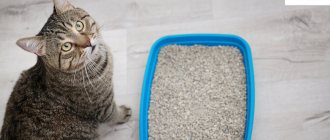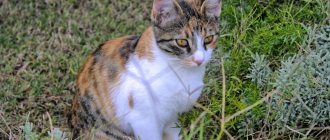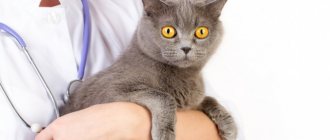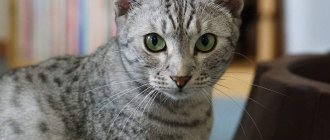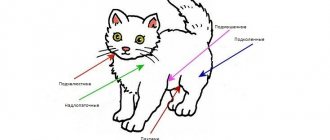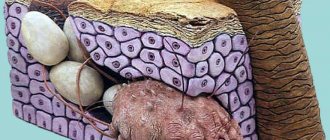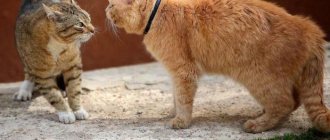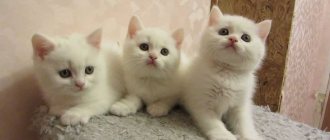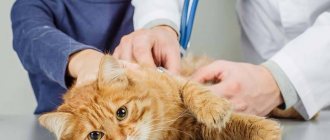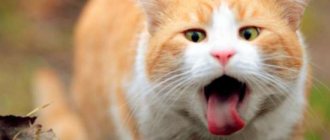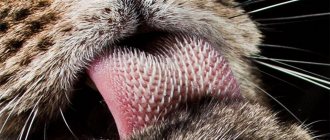Each healthy cat should normally defecate once a day, young kittens with a high metabolism can go to the litter box 2 times a day, and for aging cats the norm can be considered when they defecate once every two days.
If a cat does not defecate for a longer period of time, this should attract the attention of its owner. If you notice that your cat does not walk at all, this indicates that your cat is constipated and you need to take urgent measures to eliminate constipation.
What is constipation in a cat?
Constipation in a cat is usually called prolonged retention of feces in the intestines, when the process of bowel movement is very difficult or absent altogether. Cat owners should keep in mind that difficult defecation in itself is not a disease, but serves as one of the symptoms of a particular pathology in the animal’s body. Based on this, it is necessary to treat not the symptom of the disease, but the specific disease that led to constipation in the cat.
Etiology . There are a large number of reasons that make it difficult for a cat to defecate. One of the causes of constipation in a cat may be violations associated with the diet of feeding and maintenance:
- insufficient amount of fiber and ballast substances in food;
- feeding the cat dry food with a low intake of fluid into the body;
- giving a large number of meat bones, which are often too tough for a cat;
- dehydration;
- obesity and sedentary lifestyle;
- ingestion of fluff and wool with food;
- improper use of medications - constipation after diarrhea (side effect after long-term use of astringents).
Cat diseases:
- Diseases of the digestive system (gastroenterocolitis, hemorrhoids in cats), liver (liver disease in cats) and kidneys (kidney stones in cats - urolithiasis).
- Injuries in the pelvis and spine.
- Intestinal atony.
- Volvulus.
- Tumors in the intestines (oncology in cats).
- Pancreatitis.
- Diabetes.
- Worms (worms in cats).
- Dysbacteriosis of the large intestine.
- Blockage of the intestines with foreign objects (bones, toys).
- Intestinal flatulence (flatulence in cats).
Do cats need plant fiber?
Plant fiber is needed by herbivores and omnivores. Since cats are obligate carnivores, their stomachs are not designed to digest large amounts of plant fiber. With plant fiber, bacteria enter the cat's body and disrupt the microflora of the gastrointestinal tract. When defrosting, bacteria release gases. Not only are gases uncomfortable for cats, but they can also be toxic and lead to inflammation. Inflammation causes diarrhea.
If you decide to include plant fiber in your cat's diet, this must be done very carefully. Keep track of how often your pet burps and whether it suffers from gas or diarrhea. Due to the high fiber content, cats' bodies may be less able to absorb nutrients.
If you have constipation, you should not give fiber to cats that regurgitate frequently. Fiber makes regurgitation worse. Cats that spit up need to be fed small, frequent meals. Food should be easily digestible and have high nutritional value. Such cats may suffer from constipation because not enough food passes through the gastrointestinal tract. Frequent feeding should help relieve constipation.
What consequences can a cat have as a result of prolonged constipation?
The consequences of prolonged constipation in a cat are quite serious. As a result of prolonged constipation, a cat may experience:
- general intoxication of the body;
- rupture of the intestinal wall;
- disturbances occur in the functioning of internal organs and systems;
- the load on the heart increases.
Clinical picture . Constipation in a cat is accompanied by the following clinical signs:
- When visiting the litter box, the cat strains and strains a lot, and tries to empty itself. Even if she squeezes out something, it will only be a small amount and it will be very dry or too watery. Strained bowel movements can lead to rectal prolapse (cat rectal prolapse).
- When visiting the litter box, the cat meows weakly and makes very plaintive sounds, but she is unable to “go” to the litter box. The cat is in pain and discomfort.
- Due to gas accumulations in the intestines, bloating is noted, and the tummy is tense on palpation.
- In some cases, the cat vomits something white and foamy (cat vomiting).
- General depression sets in, the cat looks lethargic and helpless.
- The cat doesn't eat or drink anything at all.
- When examining the anus, swelling is clearly visible.
How does diet affect bowel function?
Lack of fiber and coarse plant fibers in the feed can lead to slower intestinal contractility and, as a result, constipation. Fatty and fried foods, milk, confectionery and flour products have a negative impact on the gastrointestinal tract.
Taking magnesium and foods enriched with lipids has a positive effect on intestinal function.
Important! Magnesium stimulates intestinal contractions, but increases the risk of developing urolithiasis. It is not recommended to deal with constipation in this way if your cat has kidney problems.
Often the problem of cat constipation can be solved by simply monitoring the drinking balance. Cats, unlike dogs, rarely feel thirsty, so they hardly drink water. In addition, their whiskers (vibrissae) are very sensitive. As soon as they come into contact with water or the sides of the drinking bowl, the cat experiences discomfort and refuses to drink (at the same time, it happily catches drops from the tap in the washbasin or splashes from the shower while you perform water treatments).
Liquid is necessary for normal digestion, especially with constant consumption of dry food. You cannot do without water in cases where the diet is rich in carbohydrates. Excess carbohydrates lead to a spike in sugar levels. To normalize the balance, the body tries to remove toxic substances through urination, which, in turn, increases dehydration.
Tip: Instead of a regular drinking bowl, buy a drinking fountain. It’s much more convenient and interesting for cats to drink from it.
What information should cat owners provide to the treating veterinarian?
When contacting a veterinarian, it is important to provide the following information in more detail:
- Cat's age and lifestyle.
- When was constipation discovered and how did it manifest itself?
- Has the cat ever vomited, its frequency and frequency, and the type of vomit.
- List of food fed in the last 24 hours.
- Changes in behavior, urination, defecation, appetite, thirst.
During a clinical examination of a sick cat, the veterinarian can determine the presence of foreign bodies in the intestines, the presence of inflammation of the perineum and anus, problems with the anal glands, injuries to the pelvic bones and spine.
To more accurately determine why a cat is constipated, the following may additionally be prescribed in a veterinary clinic:
- general blood analysis;
- stool analysis for oviworms;
- abdominal x-ray;
- X-ray of the intestine with contrast to assess its patency;
- Ultrasound of the abdominal cavity.
Diagnostics
To determine treatment tactics, it is necessary to find out the cause of atony. A veterinarian performs a visual examination of the cat with palpation of internal organs. The diagnosis is based on pathological history, laboratory and instrumental diagnostic methods. Basic laboratory tests:
- Blood chemistry. A detailed study of the work of internal organs.
- Coprogram. Stool analysis assessing the functioning of the digestive and excretory systems and the presence of parasites.
Instrumental diagnostics includes the following examinations:
- Radiography. The organs of the gastrointestinal tract and intestinal structures are visualized.
- Ultrasound diagnostics (ultrasound). Checking the condition and contents of internal organs.
- X-ray with contrast. The work of the intestines is examined one by one after the administration of barium sulfate (jejunum, cecum and colon after 4-6 hours, rectum after 7).
- Diagnostic laparotomy. A surgical intervention that identifies damage to the digestive organs through an incision in the abdominal wall.
Treating a cat for constipation
Before you begin treating constipation in a cat, you need to know for sure whether the cat has a defecation pathology. Make sure that the cat does not go to the litter box for 2-3 days and additionally has the symptoms listed above in the clinical picture of the disease.
In this case, you need to pay attention to the feces:
- A healthy cat's stool is usually clearly shaped, oblong, soft, and dark brown.
- Deviations in stool - excessively dry and cracked stool or, on the contrary, liquid and unformed.
- The color of the stool may also change and have shades of gray, yellow, or red.
- Foreign objects and suspicious inclusions may be observed in the stool, differing sharply in color, consistency, and texture.
Usually, cat owners themselves can help their pet when overeating or after eating excessively rough food.
Before giving any medication to your cat, it must be shown to a veterinarian. Various diseases that lead to constipation in a cat require the prescription of various medications. So, in case of helminthic infestation, the cat must be prescribed one or another anthelmintic drugs; in case of partial blockage or intestinal obstruction, Vaseline oil will help, and a saline or synthetic laxative will only cause harm to the cat.
The safest and most effective remedy for constipation in cats and kittens is considered to be Lactulose, which is a prebiotic, softens and softens feces, resulting in rapid emptying of the cat’s intestines.
Vaseline oil, like Lactulose, helps soften feces, resulting in rapid bowel movements from the cat. Vaseline oil is added to the cat's liquid food at the rate of 2-3 ml per kilogram of the animal's weight. To normalize your cat's stool, Vaseline oil is added to food 3 times a day. Vaseline oil cannot be replaced with vegetable oil (sunflower, olive, etc.), due to the fact that these oils are quickly absorbed in the animal’s body and we will create additional problems for the animal’s liver.
Do not give your cat any drops or insert laxative suppositories into the rectum. Veterinarians will most likely prescribe your cat a laxative - Duphalac, which is added to food twice a day, 0.5 ml.
It is good to give a sick cat medications that help the cat’s intestines work normally. These drugs include Bifitrilak (given with food in a dose of 0.1 once a day). The course of treatment is 10 days.
Often a cat with constipation has to undergo an enema, especially when there is a deep blockage of the intestines. With the help of a small rubber bulb and warm water, you can free the intestines from feces and dirty accumulations.
In case of severe intoxication and when the cat does not eat anything for a long time, the cat is given a drip in a veterinary clinic.
Causes of pathology
Atony in cats develops due to a weakening of the intestinal muscles and a decrease in the activity of digestive processes with a gradual increase in the difficulty of defecation.
Veterinarians identify the main causes of the disease:
- hereditary predisposition;
- congenital disorders of intestinal development and formation in kittens;
- natural aging of the body and weakening of muscles;
- diseases of the endocrine system;
- improper feeding;
- blockage of intestines with fur;
- lack of fiber in food;
- low physical activity;
- intestinal infections;
- extensive helminth infestation;
- malignant neoplasms;
- overfeeding, obesity;
- inflammatory diseases of the stomach.
Failure to comply with pet hygiene rules can cause illness.
The following factors have additional adverse effects:
- adhesions as a result of surgery;
- taking and side effects of medications;
- psychological tension and stress;
- a dirty litter tray and the cat’s reluctance to empty itself;
- decreased intestinal vascular tone.
Preventing constipation
Prevention of constipation in cats by animal owners should be based on preventing the causes that cause constipation in cats. Cat owners should:
- Constantly comb the cat's hair; buy a special paste to remove the hair and constantly swallow it.
- Exclude small and soft bones from the diet, which can be a source of traumatic intestinal damage to the cat.
- Make your cat move and play more so that exercise becomes the norm for her.
- Regularly deworm your cat.
- When feeding dry food, the cat should have free access to water.
- Add foods rich in fiber to your cat's diet.
- Prevent your cat from injuring the pelvis and spine.
- Get frequent flea prevention.
- Regularly vaccinate your cat against viral infectious diseases common in your region.
Take your cat for preventive examinations to the veterinary clinic.
Why do cats eat fur and what can replace it with?
In nature, cats eat their prey whole: meat, bones, fur and feathers. There are no nutrients in wool. It has purely mechanical functions: it helps remove plaque from teeth and increases the volume of feces. Wool is not digested in the stomach. But it takes up space in the gastrointestinal tract. Thus, wool irritates the walls of the gastrointestinal tract and stimulates peristalsis. The food mass passes through the gastrointestinal tract faster and is eliminated from the body.
The natural diet for domestic cats is very similar in composition to the natural prey of wild relatives. The difference is that no wool is added to natural food. It is replaced with vegetables. Vegetables are a source of insoluble fiber. The body does not absorb it, but it absorbs water, increasing the volume of food mass. In theory, fiber should do the same thing that wool does. But wool is a protein, and plant fiber is based on cellulose and starch.
Vaseline oil for constipation
Vaseline oil is a safe remedy that is given to a cat when there are problems with the intestines. The product can be injected through a syringe into the anus; another option is to inject it into the mouth through a syringe without a needle.
The oil can soften feces. move feces through the intestines. The pet's intestines are emptied 3-5 hours after the administration of the oil. single dose - 3-5 ml.
Enema
The procedure is carried out as follows:
- Prepare an enema solution. Dissolve a pinch of salt in warm water. Take an enema.
- Lubricate the animal's anus and the enema tip with Vaseline oil.
- Slowly insert the tip into the anus (in a circular motion).
- Pour in the solution.
- Remove the enema, press the pet's tail to the anus, hold it in your arms for 10-15 minutes.
Be sure to read:
Black feces in a cat: normal or pathological, when is it a dangerous symptom, diagnosis, how to treat
